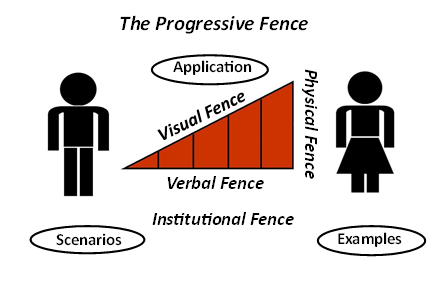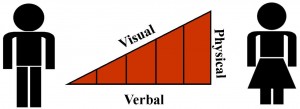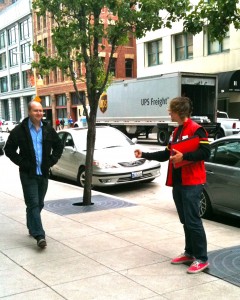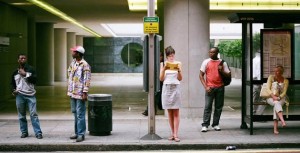
The Visual Fence - Erik Kondo

The Visual Fence is the use of body language to create Respect, Communicate the rules, and Enforce your limits on unwanted behavior.
It all starts with body language.
We can talk to people about the importance of walking with purpose, being alert and aware of our surroundings, and projecting confidence. But that is not what really happens, especially among women.
They look down, away, and avoid eye contact. They pretend to be busy by being on the phone, texting, or listening to earphones. This type of behavior will not change. It is done for a reason. It is done tocommunicate to others to not engage or talk to them. And most of the time it works. That is why the behavior will not change. Because it works most of the time.
This is the Visual Fence that is designed to communicate that the person does not want to be talked to, or interacted with in anyway. A Visual Fence uses body language to send a message. It is highly efficient. Everyone who sees it knows what it means. But it can be easily disregarded or purposely ignored.
Police use the Visual Fence to limit unwanted behavior on a regular basis. It succeeds when citizens respect the message.
The Visual Fence is a simple, but extremely powerful visual concept. And unlike verbal assertiveness, people employ and respond to some form of the Visual Fence everyday.
The problem occurs when it doesn’t work.
The Verbal Fence - Erik Kondo

The Verbal Fence is the use of clear and assertive verbal phrases to create Respect, Communicate the rules, and Enforce limits on unwanted behavior.
The Verbal Fence is a progressively higher level response than the Visual Fence. Body language is a very efficient method of communication. It allows you to send a message to many people in the vacinity with minimal effort. But it is not always effective. Many times body language is misunderstood or simply ignored.
Therefore, when the Visual Fence fails, an escalating response in the form of clear verbal communication is needed to remove any doubt of a misunderstanding. Verbal phrases can come in many forms. They are used to set a firm boundary and delineate what is the desired behavior. Or what is defined as unwanted behavior.
For example, the response of "Please leave me alone. I do not want to talk to you." leaves no room for doubt or misunderstanding. If the other party does not abide by this request, then it is clear that he or she has no respect for the speaker and his or her personal rules of behavior.
The Visual Fence can escalate as needed in both the tone of voice and the phrase employed.
For example. "Please leave me alone." can easily be followed by a stern "BACK OFF!!!" as needed. The Verbal Fence is most effective when it is accompanied by supporting body language.
NOTE:
Assertiveness as a method of communication is not a skill that is taught to most children and teenagers.
Children, especially girls, learn to use passive and indirect methods of communication from adults and their peers. They confuse assertiveness with anger. They think that when they are angry, they are being assertive. Most likely, they are actually being aggressive. They believe that they need to be angry in order to speak assertively. In a nutshell, they do not understand simple matter of fact non-emotional assertive communication.
Without the use of clear communication, boundary setting is difficult. There is no basis for engaging a higher level response because a violation of boundary is not clear. Assertive communication must be practiced continually to be effective. But unlike physical defense, there are ample opportunities to practice assertiveness in most people’s daily lives.
The following videos demonstrates examples of the Verbal Fence.
The Physical Fence - Erik Kondo

The Physical Fence is a physical action(s) that is used to create Respect, Communicate the rules, and Enforce limits on unwanted behavior.
The Physical Fence is an higher level response than the Verbal Fence. When the Verbal Fence fails, the person now has the clear signal of the violation of his or her boundary that now requires a physical action.
There is a continuum to physical responses. The degree of the response depends upon the circumstances of the situation. One the lower end, getting up and walking away is a physical response to someone who is pestering you. On the higher end, using lethal force against a deadly threat is also a form of the Physical Fence.
Whereas the Visual Fence depends upon other people having respect for behavioral boundaries, the Verbal Fence is more about clear communication of those boundaries. On the other hand, the Physical Fence is more about enforcement of behavior limits.
About the top photo.
1967 Boston Marathon
While attending college, Switzer entered and completed the race in 1967 under entry number 261 five years before women were officially allowed to compete in it. She registered under the gender-neutral "K. V. Switzer". She was issued a number through an "oversight" in the entry screening process, and was treated as an interloper once the error was discovered.
The following videos demonstrate the Physical Fence WITHOUT a prior Verbal Fence.
Institutional Fence

The Institutional Fence is the power of government, institutions, and policing agents to create respect, communicate the rules, and enforce limits on unwanted behaviors.
Every civilized society has their own version of the Institutional Fence. Many societies that have a very weak Institutional Fence are characterized by chaos and mayhem (Samolia for example). In these societies, enforcement of the rules and laws are sporadically and not reliably enforced. Fear and personal insecurity is commonplace.
On the other hand, societies such as North Korea, that have a very powerful Institutional Fence are know for governmental human rights abuses. The societies are known for their draconian enforcement of the rules and laws that control behavior. Fear of government authority and policing agents is commonplaces.
A society that has a just and fair Institutional Fence is a secure culture where its citizens have trust in each other and in government. Such a society is characterized by respect for the rules, clear communication of the rules and laws of behavior, and appropriate enforcement of those rules and laws.
Watch how the police in this video enforce the rules of behavior and create respect for those rules among the crowd by using an appropriate level of enforcement.
Video Links:
Apply the Progressive Fence

The Visual Fence is a powerful concept because it represents the first response to a potential confrontation. It is engaged by body language that conveys of a message of “I am not interested in engaging with you.”
The Visual Fence is so widely used because it is a passive response that is universally understood and recognized. It is generally thought to be a non-confrontational response.
All women and girls know how to ignore the “creepy” guy with "not interested" body language. They have learned from experience.
The police actively use the Visual Fence to limit behavior. The point is to illustrate that the Visual Fence need not only be passive and submissive. The Visual Fence can also be strong, confident body language too.
The Verbal Fence is the Progressive (escalating) Response to a violation of the Visual Fence.
An assertive verbal phrase is needed because the Visual Fence has been violated. The violation breaks the visual boundary that has been set. Therefore, a high level verbal boundary must be created, this is the Verbal Fence.
The Verbal Fence consists of assertive verbal phrases such as “Not interested, “Leave me alone”, “Back off!” These phrases are the natural escalation of the emotion and desire of not wanting to engage with someone. Therefore, using a “Not interested! response is the easiest method for executing the Verbal Fence in response to unwanted attention.
The Physical Fence
A willful violation of the Verbal Fence leaves no doubt as to the bad intentions of the violator. A Progressive (higher level) Response in the form of some type of physical action is required. This action is the final stage of the Progressive Fence. It is the Physical Fence.
The Physical Fence is any type of bodily movement or action that is designed to limit behavior. It is most effective when it incorporates the body language of the Visual Fence and the assertive voice of the Verbal Fence.
The Physical Fence is used by law enforcement regularly to control and limit behaviors. It is part of the Use of Force Continuum and represents a wide variety of responses.
The following video shows an example of the Progressive Fence in response to unwanted behavior. In this case, has the Verbal Fence been stronger and more effective, there may have been no need to employ the Physical Fence.
This video shows the Institutiona Fence along with the progression from Verbal Fence to Physical Fence.
Scenario #1

You are walking down the sidewalk. In front of you is a street promoter handing out flyers.
If you are not interested in receiving a flyer, you would engage your Visual Fence. You use body language to communicate that you do not want the flyer. If the promoter, ignores your signal and approaches, you engage the Verbal Fence by stating “Thank you, but I am not interested.” If he thrusts his arm in front of you blocking your path, you assertively brush it aside with your hand while repeating “Not interested!”.
Your brush off was your Physical Fence. You have used the concept of the Progressive Fence to communicate your feelings in an escalating manner as the situation warranted.
Scenario #2

You are waiting at the bus stop. A man attempts to “catch your eye”.
You engage the Visual Fence and confidently occupy yourself with tasks (reading, texting, etc) in order to convey that you are not interested in interacting with him. He approaches you and attempts to start a conversation. You engage the Verbal Fence and state that you are “not interested in conversation.” He ignores your statement and comes closer. You engage the Physical Fence by raising both your arms in front of you with palms forward and take a strong step back while firmly stating “I am not interested! Move back!”
The actual phrases used are less important than the progressive nature of your responses. Your actions in both these scenarios are examples of using the Progressive Fence in order to create Just-Right Responses in situations of confrontation.
Common Q & A

1. You are at a party, you don’t want to dance. What do you do?
You engage the Visual Fence in the form body language to communicate to people that you are not interested in dancing.
2. Someone ignores your body language and comes over and asks you to dance. What do you do?
You engage the Verbal Fence in the form of assertive phrases such as “No thanks”, “Not interested”, “Not now”, etc to communicate that you are not interested in dancing.
3. The person grabs your arm and pulls you towards the dance floor. What do you do?
You engage your Physical Fence in the form of knocking the person’s grab off while repeating your assertive phrase at a higher verbal level.
4. Your date/friend/stranger is sitting next to you on the couch. You are not interested in physical contact with him or her. What do you do?
You engage the Visual Fence in the form of body language to communicate you are not interested in being touched by him or her.
5. The person ignores your body language and moves closer. What do you do?
You engage the Verbal Fence and use an assertive phrase to tell him or her to give you space.
6. The person ignores your request/command and puts his or her arm around you. What do you do?
You engage your Physical Fence and push the person away, while repeating a verbal command such as “Back off!”, and you physically exit the situation.
7. You are the Person who is trying to get physically closer to another. That person engages a Visual Fence, or Verbal Fence. What do you do?
You respect the person’s wishes and limit your behavior as communicated.
8. You observe someone else trying to take advantage of another. What do you do?
You engage your Visual, Verbal Fence, or Physical Fence as the situation warrants to communicate and enforce the limiting of the behavior.
The Progressive Fence
The Progressive Fence is a model that utilizes progressive (escalating responses) of the Visual Fence (body language), Verbal Fence (assertive phrases), Physical Fence (physical actions), and Institutional Fence (power of government) to control and limit unwanted behavior.